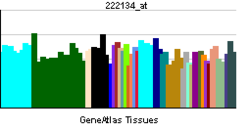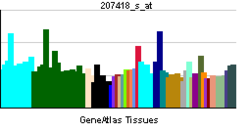- DDO (gene)
-
D-aspartate oxidase Identifiers Symbols DDO; DASOX; DDO-1; DDO-2; FLJ45203 External IDs OMIM: 124450 MGI: 1925528 HomoloGene: 101531 GeneCards: DDO Gene EC number 1.4.3.1 Gene Ontology Molecular function • D-amino-acid oxidase activity
• binding
• D-aspartate oxidase activity
• oxidoreductase activityCellular component • peroxisome Biological process • aspartate catabolic process
• oxidation-reduction processSources: Amigo / QuickGO RNA expression pattern 

More reference expression data Orthologs Species Human Mouse Entrez 8528 70503 Ensembl ENSG00000203797 ENSMUSG00000063428 UniProt Q99489 Q0E9Q7 RefSeq (mRNA) NM_003649.2 NM_027442.5 RefSeq (protein) NP_003640.2 NP_081718.2 Location (UCSC) Chr 6:
110.71 – 110.74 MbChr 10:
40.35 – 40.4 MbPubMed search [1] [2] D-aspartate oxidase is an enzyme that is encoded by the DDO gene.[1][2]
The protein encoded by this gene is a peroxisomal flavoprotein that catalyzes the oxidative deamination of D-aspartate and N-methyl D-aspartate. Flavin adenine dinucleotide or 6-hydroxyflavin adenine dinucleotide can serve as the cofactor in this reaction. Two (or four, according to Q99489) transcript variants encoding different isoforms have been found for this gene.[2]
References
- ^ Setoyama C, Miura R (Jul 1997). "Structural and functional characterization of the human brain D-aspartate oxidase". J Biochem 121 (4): 798–803. PMID 9163533.
- ^ a b "Entrez Gene: DDO D-aspartate oxidase". http://www.ncbi.nlm.nih.gov/sites/entrez?Db=gene&Cmd=ShowDetailView&TermToSearch=8528.
Further reading
- Barker RF, Hopkinson DA (1977). "The genetic and biochemical properties of the D-amino acid oxidases in human tissues". Ann. Hum. Genet. 41 (1): 27–42. doi:10.1111/j.1469-1809.1977.tb01959.x. PMID 21608.
- Van Veldhoven PP, Brees C, Mannaerts GP (1991). "D-aspartate oxidase, a peroxisomal enzyme in liver of rat and man". Biochim. Biophys. Acta 1073 (1): 203–8. PMID 1991137.
- Nagasaki H (1994). "Gender-related differences of mouse liver D-aspartate oxidase in the activity and response to administration of D-aspartate and peroxisome proliferators". Int. J. Biochem. 26 (3): 415–23. doi:10.1016/0020-711X(94)90062-0. PMID 8187937.
- Simonic T, Duga S, Negri A et al. (1997). "cDNA cloning and expression of the flavoprotein D-aspartate oxidase from bovine kidney cortex". Biochem. J. 322 ( Pt 3): 729–35. PMC 1218248. PMID 9148742. http://www.pubmedcentral.nih.gov/articlerender.fcgi?tool=pmcentrez&artid=1218248.
- Amery L, Brees C, Baes M et al. (1999). "C-terminal tripeptide Ser-Asn-Leu (SNL) of human D-aspartate oxidase is a functional peroxisome-targeting signal". Biochem. J. 336 ( Pt 2): 367–71. PMC 1219880. PMID 9820813. http://www.pubmedcentral.nih.gov/articlerender.fcgi?tool=pmcentrez&artid=1219880.
- Zaar K, Köst HP, Schad A et al. (2002). "Cellular and subcellular distribution of D-aspartate oxidase in human and rat brain". J. Comp. Neurol. 450 (3): 272–82. doi:10.1002/cne.10320. PMID 12209855.
- Strausberg RL, Feingold EA, Grouse LH et al. (2003). "Generation and initial analysis of more than 15,000 full-length human and mouse cDNA sequences". Proc. Natl. Acad. Sci. U.S.A. 99 (26): 16899–903. doi:10.1073/pnas.242603899. PMC 139241. PMID 12477932. http://www.pubmedcentral.nih.gov/articlerender.fcgi?tool=pmcentrez&artid=139241.
- Mungall AJ, Palmer SA, Sims SK et al. (2003). "The DNA sequence and analysis of human chromosome 6". Nature 425 (6960): 805–11. doi:10.1038/nature02055. PMID 14574404.
- Gerhard DS, Wagner L, Feingold EA et al. (2004). "The status, quality, and expansion of the NIH full-length cDNA project: the Mammalian Gene Collection (MGC)". Genome Res. 14 (10B): 2121–7. doi:10.1101/gr.2596504. PMC 528928. PMID 15489334. http://www.pubmedcentral.nih.gov/articlerender.fcgi?tool=pmcentrez&artid=528928.
Categories:- Human proteins
- Chromosome 6 gene stubs
Wikimedia Foundation. 2010.
